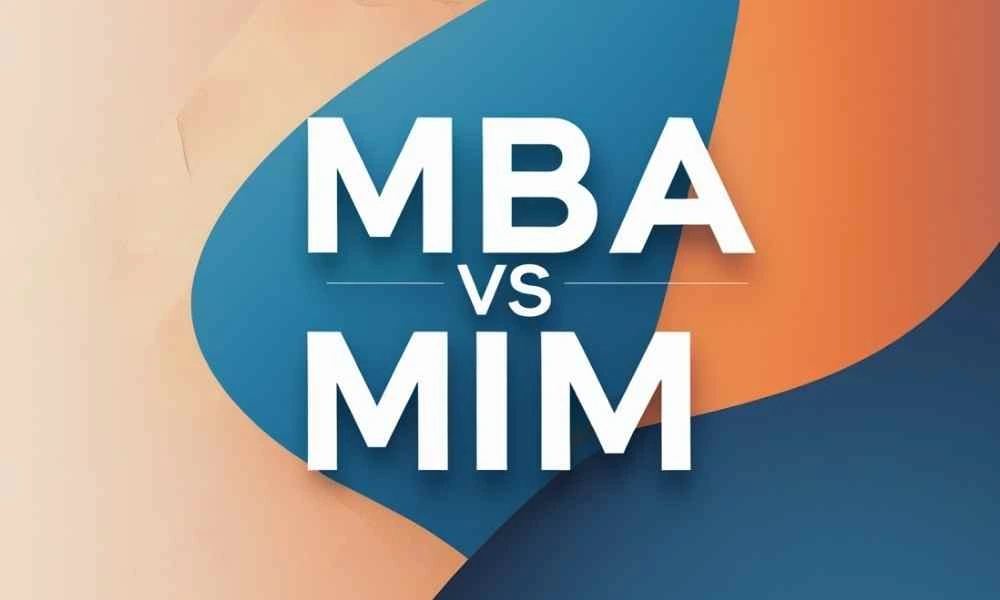MBA vs MIM: Which Is the Right Choice for You in 2025?
Table of Contents
Thinking about stepping into the world of business but not sure whether to go for an MBA or a MIM? You’re not alone! With so many top schools and exciting career opportunities out there, choosing between a Master of Business Administration (MBA) and a Master in Management (MIM) can feel overwhelming—especially in 2025 when both programs are evolving fast.
Here’s the good news: there’s no one-size-fits-all answer. Each degree has its own vibe, price tag, and career path. Whether you’re a fresh graduate trying to get your foot in the door or a working professional ready to level up, this guide will help you figure out which program fits your background, goals, and budget best. Let’s dive in!
What Is the Difference Between MBA and MIM?
If you’re planning a career in business, you’ve probably come across two popular programs: the MBA (Master of Business Administration) and the MIM (Master in Management). While both can take you into the world of leadership and strategy, they are designed for different stages of your career—and choosing the right one in 2025 depends on your experience, goals, and budget. According to a 2024 survey by GMAC (Graduate Management Admission Council):
- Over 85% of MBA applicants had 3+ years of work experience.
- More than 70% of MIM applicants were under 25 with less than 2 years of experience.
- The demand for MIM programs increased by 11% globally in the last two years—especially in Europe and Asia.
- Meanwhile, MBA programs remain the top choice in the U.S., UK, and Canada for mid-level professionals aiming for executive roles.
Let’s break down the key differences between the two in a clear, easy-to-digest format:
| Aspect | MBA (Master of Business Administration) | MIM (Master in Management) |
| Target Audience | Working professionals (typically 3–9 years of experience) | Recent graduates or early career starters (0–2 years of experience) |
| Curriculum Focus | Strategic leadership, global business, finance, innovation, entrepreneurship | Core management subjects—finance, marketing, operations, HR |
| Learning Style | Case studies, peer collaboration, experiential learning | Lecture-based, theory-driven, foundational business concepts |
| Typical Age Range | 26–35 years old | 21–25 years old |
| Global Popularity | Most popular in the U.S., Canada, and top UK B-schools | Common in Europe and growing in Asia and Australia |
| Classroom Profile | Diverse cohort with experience in finance, consulting, tech, etc. | Mostly fresh grads from diverse academic backgrounds |
| Career Level Post-Graduation | Mid- to senior-level roles (e.g. Managers, Directors, Consultants) | Entry-level to junior-level roles (e.g. Analysts, Assistants) |
Studying MBA in Canada: Top Colleges, Cost, Eligibility, and More
Studying MBA in UK: Top Colleges, Cost, Eligibility, and More
When Should You Choose MIM Over MBA (and vice versa)?
If you’ve been asking yourself, “Should I go for an MBA or a MIM in 2025?”—you’re not alone! With the rising number of international students exploring business education, the MBA vs. MIM debate is hotter than ever. In fact, according to the 2024 GMAC Prospective Students Survey, around 67% of MIM applicants are under 25 with less than two years of full-time work experience.
Meanwhile, MIM applications in Europe and Asia have grown by 12% year-on-year, while MBA remains dominant in the U.S., Canada, and the UK. Both degrees are powerful in their own right—but they serve different purposes depending on where you are in your life and career. So, how do you decide which one suits you better? Let’s break it down clearly and simply:
| Criteria | Choose MIM (Master in Management) | Choose MBA (Master of Business Administration) |
| Work Experience | 0–2 years (fresh graduates or early-career professionals) | 3–10 years of experience across sectors |
| Academic Background | Ideal for students with non-business or general bachelor’s degrees | Often suited for professionals with any degree but relevant work experience |
| Tuition Cost | €20,000–€50,000 on average; budget-friendly | $70,000–$150,000 on average; higher fees with greater earning potential |
| Peer Network | Mostly fellow recent grads—academic and early-career focused | More diverse—experienced professionals from tech, finance, healthcare, and other industries |
| Best for Career Switching | Less effective unless you pursue further qualifications later | Perfect for changing roles, industries, or geographies |
Which one Has Better Global Recognition: MBA or MIM?
If you’re planning to work internationally after graduation, one of the biggest questions you might have is: “Will employers recognize my degree across the globe?” Both the MBA (Master of Business Administration) and MIM (Master in Management) have a strong presence in business education—but their level of global recognition varies by region and industry. According to the GMAC Global Hiring Report 2024:
- Over 92% of global recruiters said they are actively hiring MBA graduates.
- In contrast, 62% of employers outside Europe were familiar with the MIM degree—especially in North America and Asia, where MIM is still emerging.
- In Europe, however, MIM degrees are almost as widely recognized as MBAs, especially in Germany, France, and the Netherlands.
So, which degree gives you the best international credibility in 2025? Let’s break it down:
| Region | MBA Recognition | MIM Recognition |
| North America | Extremely high—considered the gold standard for leadership roles | Limited awareness—less popular among U.S. employers |
| United Kingdom | Highly respected—especially from top B-schools like Oxford, LBS, Cambridge | Gaining strong ground—popular at LSE, Warwick, and Imperial |
| Europe | Well-known, especially at schools like INSEAD, IE, HEC Paris | Very popular—core offering at top schools like ESCP, ESMT, and Rotterdam School |
| Asia-Pacific | Widely recognized—especially in India, Singapore, Hong Kong, and Australia | Emerging—some recognition, but still building employer familiarity |
| Middle East & Africa | Recognized among global firms and executive recruiters | Still new—may require explanation in job interviews |
Cost Comparison: Is MBA More Expensive Than MIM?
Let’s be honest—business school isn’t cheap, and the cost of your degree is a big factor when deciding between an MBA and a MIM. While both offer valuable career outcomes, the financial investment required for each can be very different. According to recent surveys in 2025, the average cost of a full-time MBA from a top global school ranges from $100,000 to $165,000+—excluding living expenses.
A MIM program, on the other hand, usually costs between $30,000 to $60,000, making it more accessible for younger graduates. The cost gap is significant, especially for international students or those early in their careers. However, the ROI (return on investment) may also differ depending on career stage, post-grad salaries, and location. Let’s break it down with real numbers:
| Aspect | MBA (Master of Business Administration) | MIM (Master in Management) |
| Tuition Fees (Top Schools) | $100,000 – $165,000+ (e.g., Wharton, LBS, INSEAD) | $30,000 – $60,000 (e.g., ESCP, IESEG, Rotterdam School of Management) |
| Work Experience Required | 3–10 years | 0–2 years |
| Living Expenses (2 years) | $40,000 – $60,000 | $20,000 – $35,000 (shorter program duration = lower cost) |
| Total Program Cost Estimate | $140,000 – $225,000+ | $50,000 – $90,000 |
| Scholarship Availability | Widely available but competitive (merit + need-based) | Available, particularly in European universities |
| Average Starting Salary | $110,000 – $160,000 (post-MBA, top firms) | $50,000 – $80,000 (post-MIM, entry-level roles) |
| Typical ROI Timeframe | 3–5 years | 1–3 years |
Top Universities for MBA and MIM Programs in 2025
So, you’ve narrowed down your path—MBA or MIM—but what about the university? Choosing the right school is just as important as choosing the right degree. It impacts your network, learning experience, post-grad opportunities, and even your visa chances if you’re an international student. According to the Financial Times 2024 Global Rankings:
- MBA programs from top U.S. schools continue to dominate global leadership roles and post-grad salaries.
- Meanwhile, MIM programs in Europe have seen a 15% surge in international student enrollments, driven by shorter durations, lower tuition, and excellent placements.
- Schools like HEC Paris, ESCP, and LBS consistently appear in the top 10 for MIM, while Harvard, Wharton, and INSEAD lead the MBA race.
Whether you’re after a global alumni network, a startup-friendly environment, or a finance-focused curriculum, here’s a handy table to help you compare.
| School Name | Program Type | Country | Key Highlights | 2025 QS/FT Ranking |
| Stanford Graduate School of Business | MBA | USA | #1 for innovation and entrepreneurship; high ROI; Silicon Valley access | #1 QS MBA |
| University of Pennsylvania (Wharton) | MBA | USA | Renowned for finance, dual degrees, and Ivy League alumni | #2 FT MBA |
| Harvard Business School | MBA | USA | Famous case method, elite network, leadership-focused curriculum | #3 QS MBA |
| INSEAD | MBA | France/Singapore | 1-year MBA, highly international class, great for global mobility | #4 FT MBA |
| London Business School (LBS) | MBA & MIM | UK | Strong in both MBA and MIM; great for consulting and finance roles in Europe | Top 5 in both |
| HEC Paris | MIM | France | #1 MIM globally; rigorous academics + excellent placement record | #1 FT MIM |
| ESSEC Business School | MIM | France | Flexible curriculum with tracks in digital, finance, and sustainability | #4 FT MIM |
| IE Business School | MIM | Spain | Entrepreneurial spirit, international exposure, and customizable program | Top 10 FT MIM |
| Rotterdam School of Management (RSM) | MIM | Netherlands | Sustainability-focused, multicultural campus, great for career services | Top 15 FT MIM |
| ESCP Business School | MIM | France/Germany/UK | Campuses across Europe; multilingual education; international internships | Top 5 FT MIM |
Conclusion
So—MBA or MIM? The answer really depends on where you are and where you want to go.
- If you’re early in your career, want a solid foundation in management, and prefer an affordable path with quicker ROI—MIM could be your ideal launchpad.
- But if you have a few years of work experience and are aiming for leadership roles, higher salaries, or career shifts—MBA might be the power move you need.
Whichever route you choose, both degrees are respected, valuable, and designed to boost your business game. The key is choosing based on your timeline, your goals, and your budget.
Frequently Asked Questions
What is the main difference between MBA and MIM?
The main difference is your career stage.
MBA is for professionals with 3–10 years of work experience.
MIM is for recent graduates or those with less than 2 years of experience.
MBAs focus on leadership and advanced strategy, while MIMs teach core business fundamentals.
Who should do MIM instead of MBA?
You should choose MIM if:
You’re a recent graduate (21–25 years old).
You have little or no work experience.
You want a more affordable business degree.
It’s a great first step into the business world.
Is MBA better than MIM?
Not necessarily—it depends on your goals.
MBA is better for career changers or those aiming for executive roles.
MIM is ideal for entry-level roles or exploring different industries.
Both have their own advantages based on your career path.
Which degree has more global recognition: MBA or MIM?
MBA is more widely recognized globally, especially in the U.S., Canada, Asia, and the Middle East. On the other hand, MIM is well-known in Europe and gaining popularity in Asia. If you plan to work globally, an MBA may offer broader recognition.
Is MIM cheaper than MBA?
Yes, MIM is significantly more affordable.
Average MIM tuition: $30,000–$60,000
Average MBA tuition: $100,000–$165,000
MIM is budget-friendly and offers faster ROI for early-career students.
What are the top universities for MIM and MBA in 2025?
Top MBA schools include universities like Stanford, Harvard, Wharton, INSEAD and LBS. While top MIM schools include universities like HEC Paris, ESCP, ESSEC, IE Business School and RSM.







